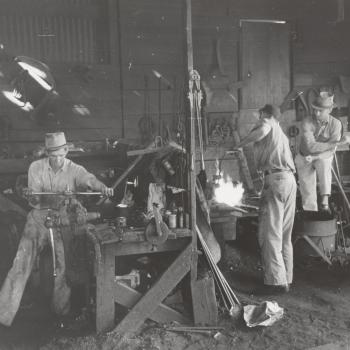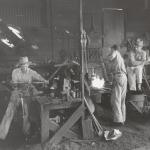Beginning in this century’s early days many towns and mid-sized cities explored strategies for post-industrial life. Maybe the big-box retail store near the Interstate can do the trick, despite its obvious limitations. Maybe a new soccer stadium will entice people to come back downtown in the evening. Maybe marketing our town’s tourist attractions will lead others to invest here. Hundreds of urban planners got interested in Richard Florida, who caused a stir with his prescriptive Rise of the Creative Class (Basic Books, 2002). A town can recover from its post-industrial slump, Florida opined, if it can attract and retain a sufficient number of educated young adults by way of universities, trendy neighborhoods, an art scene, sports venues, public transportation, medical and research facilities, skilled jobs and more. In his popular book and talks Florida used charts, a global creativity index and lots of examples to imply that any place has the potential to thrive.
James Fallows and Deborah Fallows tackle the same topic but use a different method in Our Towns: A 100,000 Mile Journey into the Heart of America (Pantheon Books, 2018). Over a period of four years they spent two weeks or more in each of 25 towns. They also spent a shorter time in each of 25 other towns. Their method is subjective, though they had a general plan and their book names some criteria for post-industrial success. There is a temptation to think of a local problem (the closing of a factory or an outbreak of opioid deaths) as a symptom of a national problem and to quickly overlook local success stories, the Fallows say. Yet parts of our country “have been doing better in most ways than most Americans realize.”
One city on the Fallows’ itinerary has three major league teams—baseball, hockey and football. All the others are smaller. A few are better known—Duluth, Birmingham and Louisville. Several are not widely known—Eastport, Maine or Caddo Lake, Texas or Holland, Michigan. No place is a utopia. They all have an uneven experience of improvement. And a few of the selected places, like Erie, Pennsylvania, are big maybes; the city’s improvement clock might soon turn backwards.
I have the same interest as the Fallows. I go back to the same five or six towns once or twice a year, spending a couple days in the town each time. I also collect books and articles about places I visit. My method is totally informal. I too have derived some conclusions, comparable to the Fallows’ “Ten and One/Half Signs of Civic Success.”
Put away a distinction between cause and effect. Don’t get obsessed with the difference between, for example, “This rehab project should bring prosperity to our town” and “This rehab project is an outcome of our town’s new prosperity.” There are no gimmicks. Isolated one-offs (a monorail to nowhere or a public-funded basketball arena) don’t do the trick. Prosperity is an imprecise mix of soft things (attention to local history, for example, or a top quality alternative newspaper or refurbishing a museum) and hard things (attracting a manufacturer of specialized surgical tools or a major windmill project).
All the ingredients of post-industrial prosperity are controversial, more or less. Immigrants and refugees are quite controversial because they almost always sharpen a town’s issues. There are three general strategies. A town can actively resist immigrants. That town’s median age will increase and its property values will depreciate. Or, a town can basically ignore the topic of immigrants. That town will muddle along until a fairy godmother puts a pot of gold on each front porch; or not. Finally, a town can attract and retain immigrants–Somalis, Hmong, Sudanese, those from India or Latin America or Eastern Europe.
The critics of immigrants “make some good points,” concedes Richard Longworth in his important book, Caught in the Middle (Bloomsbury, 2008). But Longworth, who spent “months of travel and study through the towns and cities of the Midwest,” knows “the expense and the problems [of having new immigrants] are great, but the payoff is greater.” Right now, our post-industrial towns need all the immigrants they can get, he concludes.
Some of the anti-immigrant claims about crime and the like are fake news. Some anti-immigrant feeling is lousy resentment. “My ancestors spoke English, these people don’t.” Wrong on two counts, unless the ancestors were Irish. “My ancestors worked hard to build this town, these people don’t.” Wrong on one count. The solution to the immigrant problem—presuming a town wants prosperity—is education, says Longworth. Not anti-immigrant sloganeering.
The Fallows have the same opinion. A town that emerges from a post-industrial slump does so, in part, because it attracts and assists immigrants who, given some time and patience, exponentially add money and social capital to that town. Immigrants are engineers, hospital workers, home improvement contractors, designers, teachers, motel housekeepers, food processing workers, church-goers, sports enthusiasts and, given a chance, eager students and patriotic citizens.
The Fallows’ list is thought-provoking. Among their items that match my own observations, I like two in particular.
A town is where it is for a reason. A rural town was settled near a railroad junction, for example. More frequently, a town began because a river provided power for mills and/or for transportation. Or a town began because its place on a lake was a suitable harbor. Therefore, a plan for a town’s second life ought to figure out how its location can again be an advantage. Thus many towns are investing in river parks and walkways, in a riverfront restaurant row, in condo developments overlooking the lake or riverfront.
The Fallows are fond of local breweries, and so am I. A small brewery does not create hundreds of jobs. So don’t think of it as a primary cause of vitality. But it is a symbol to young adults that good things are happening. It also can attract or augment other small ventures, like new restaurants, art studios and the like. Why order beer from a Netherlands-based company? Drink local. It tastes better and supports our own economy.
Droel edits INITIATIVES (PO Box 291102, Chicago, IL 60629), a newsletter about faith and work.











